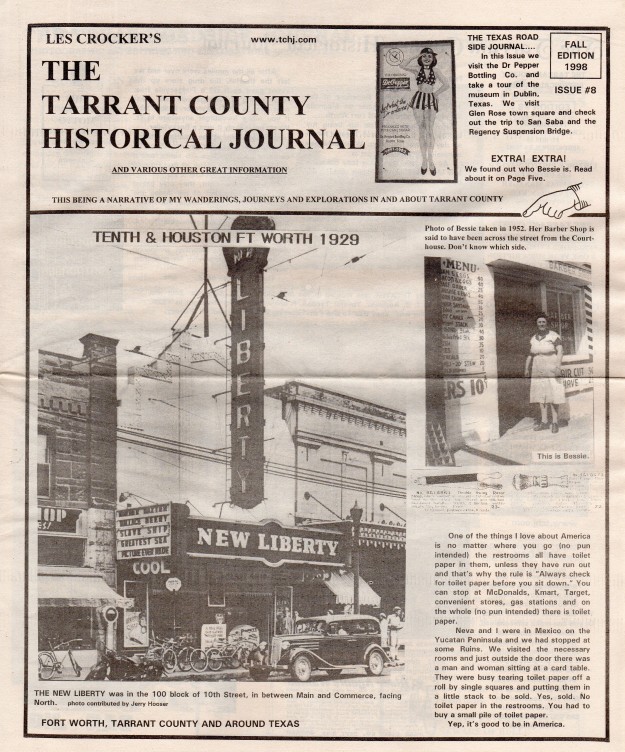From the Editor Saturday morning, sometime in the 1950’s, the Tivoli Theater on Magnolia Ave. near the south side of Fort Worth. Mom would drive us (“us” being my brother and I) to the Tivoli Theater for an all day movie marathon. We would pay admission of 9 cents to get in. As we gave the ticket lady our dime and she gave us our ticket and 1 cent back, there was always one guy standing by the window wanting your penny change. When he got 9 cents in pennies, he got in free, and he did get your penny. Inside we bought popcorn and a drink for a nickel each. We saw two full movies, a newsreel, and about 4 or 5 cartoons and a serial. The one I remember best was “Superman and the Mole Men”. I wonder if you can still see that one anywhere? After all the movies were over and we left the theater, the drug store up the street gave each kid a fudgesicle free. After eating the fudgesicle, we went next door to the Rockyfeller. In the ’50’s if you ate a hamburger anywhere in Ft. Worth, most likely it was a Rockyfeller. We sat down at the counter, ordered a hamburger that cost around 15 or 20 cents, a pack of chips about 5 cents and a soda for 5 cents. After all that I would order a slice of Boston Creme Pie. If I remember right, they only baked and served that kind of pie during the winter months. I have looked, but I can’t find anyplace that makes the kind of Boston Creme Pie that 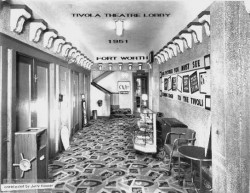 I remember. As my brother and I stood on the curb waiting for Mom to pick us up, we were thinking about next Saturday, wondering if Superman would survive his encounter with Kryptonite. The 50’s were good. The Tivoli Theater was located in the 800 block of West Magnolia Ave. built and owned by I. B. Adelman, Theater Tycoon. It opened on Christmas night in 1929. The first film was “They Had To See Paris” starring Will Rogers and Fifi D’Orsay. Next door to the Tivoli was Rockyfeller Hamburger Stand #15, opened in 1939.
I remember. As my brother and I stood on the curb waiting for Mom to pick us up, we were thinking about next Saturday, wondering if Superman would survive his encounter with Kryptonite. The 50’s were good. The Tivoli Theater was located in the 800 block of West Magnolia Ave. built and owned by I. B. Adelman, Theater Tycoon. It opened on Christmas night in 1929. The first film was “They Had To See Paris” starring Will Rogers and Fifi D’Orsay. Next door to the Tivoli was Rockyfeller Hamburger Stand #15, opened in 1939.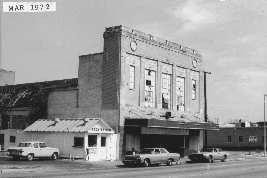
Back in Issue #3 we ran the picture that you see on Page One of “Bessie”. This picture was taken in 1952. I found it at a flea market and didn’t know if it was taken in Fort Worth or not. Well, we have since found out this was Bessie Kelley, and she is standing in front of her Barber Shop.
 Pioneers Rest Cemetery This burial ground was started in the summer of 1850 upon the deaths of Sophie and Willis Arnold, children Major Ripley A. Arnold, Commander of the Troops at Fort Worth. Many early Fort Worth settlers, including 75 Civil War Veterans are buried here.
Pioneers Rest Cemetery This burial ground was started in the summer of 1850 upon the deaths of Sophie and Willis Arnold, children Major Ripley A. Arnold, Commander of the Troops at Fort Worth. Many early Fort Worth settlers, including 75 Civil War Veterans are buried here. 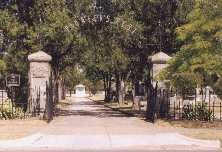 Buried here also are Major Arnold and General Edward H. Tarrant for whom Tarrant County was named. General Edward H. Tarrant arrived in Texas in November 1835 settling in Red River County. He served in the Republic of Texas Congress and became a Brigadier General in the Texas Militia in 1839. He commanded the Texas Rangers at the Battle of Village Creek in present Tarrant County in 1841. With George W. Terrell, negotiated treaties with many of the Texas Indian tribes at Bird’s Fort in 1843. He died in Parker County in 1858 and was buried there. In 1928 his body was reentered here by the Daughters of the Republic of Texas. Tarrant County was named in his honor. Pavilion Street
Buried here also are Major Arnold and General Edward H. Tarrant for whom Tarrant County was named. General Edward H. Tarrant arrived in Texas in November 1835 settling in Red River County. He served in the Republic of Texas Congress and became a Brigadier General in the Texas Militia in 1839. He commanded the Texas Rangers at the Battle of Village Creek in present Tarrant County in 1841. With George W. Terrell, negotiated treaties with many of the Texas Indian tribes at Bird’s Fort in 1843. He died in Parker County in 1858 and was buried there. In 1928 his body was reentered here by the Daughters of the Republic of Texas. Tarrant County was named in his honor. Pavilion Street 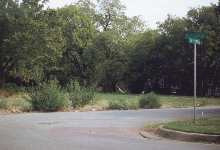 At the corner of Samuels and Pavilion St. was the Pavilion. It was a recreation facility, meeting hall and saloon. It was closed in 1905. Mr. P. C. Grunewald, owner of the Pavilion, tore it down and used the lumber to build him a house at 1106 Samuels. While he was at it, he built six other smaller houses on Pavilion St. that he used for rental property. The Saloon at Grunewald Pavilion was in the basement. After the buildings were torn down, the basement saloon was filled with sand and later a peach orchard was planted on it. Dear Les,
At the corner of Samuels and Pavilion St. was the Pavilion. It was a recreation facility, meeting hall and saloon. It was closed in 1905. Mr. P. C. Grunewald, owner of the Pavilion, tore it down and used the lumber to build him a house at 1106 Samuels. While he was at it, he built six other smaller houses on Pavilion St. that he used for rental property. The Saloon at Grunewald Pavilion was in the basement. After the buildings were torn down, the basement saloon was filled with sand and later a peach orchard was planted on it. Dear Les, 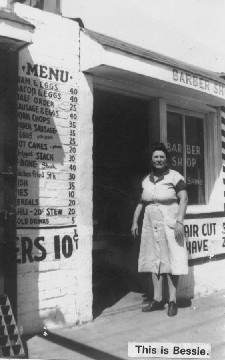 I just talked to my grandmother, Bonnie Walter, and she told me quite a bit more about Bessie Kelley. Bessie was widowed early in life and never remarried. She had one daughter, Mary. Bessie was of Indian lineage, and my grandmother admired her tenacity in making a living for herself and her daughter all on her own. We know she was a barber when “ladies” didn’t barber, and for state/county payment, she would board out her garage apartment to a couple of men at a time. In her later years, she peddled anything and everything at the First Monday Flea Market in Weatherford. She raised puppies and sold them along with anything else she could get her hands on to sell. She took her nephew out of a state run home. My grandparents ran a dairy, and Bessie would come by every week or so for fresh milk. My grandmother was a friend to Bessie. On several occasions when she was sick, my grandmother would buy groceries and medicine and take it to her at home. My grandmother lost touch with Bessie when old age forced her into a nursing home in Ft. Worth, but we know she lived to be in her 80’s. Kelly McIlveene Child’s Grave Sometime in the 1870’s, probably summertime, a wagon train snakes it’s way down a dirt trail heading west. Mother and father in the front driving the team, children playing in the back, as all children would, when the sun would get unbearably hot. It is hot and dusty and sweat everywhere. Wagon wheels creaking from lack of grease, horses and mules braying under the load, constantly on the lookout for danger and always under the eye of buzzards looking for an easy meal. Anticipation of getting out West and this journey being over. Home to the Promise Land. Suddenly the wagon wheel hits a rock or a hole. The wagon lurches sideways. A little girl, just 3 years old, loses her balance and falls out of the wagon. A scream is heard from the other children and from the wagon behind. The mother and father rush to her side. But to no avail. The fall has killed her. So, with the Wagon Master wanting to push on as soon as possible, the decision was made to bury her there almost where she fell. As the wagon train pulled off into the west, mother and father were the last wagon to leave, lagging far behind, reluctant to let the grave of their beloved child out of their sight, for they knew that they would never see the grave again. That tragic day would follow them on their journey out West and live with them for the rest of their lives. >Who are you, little girl? 1998, 128 years later, Neva and I drive through what now is the community of Sipe Springs. We come to County Road 105 heading east. It is a dirt road. It’s a Sunday. It is hot and dusty. About a mile and a half from the paved road we see it. It is on the left side just barely off the road. The grave of the little girl is out in the middle of nowhere. All by itself. No houses. Probably looks like it did in 1870. We stop and get out of the truck. It is evident that the grave is looked after. There are three markers. The original one long ago gone. One marker says, “Who is the little girl? Age 3, 1870’s”. Another says, “Little Girl, Age 3, name unknown, died 1870, Moving West”. There is evidence of a lot of visitors. It seems every one tries to leave a memento. After rummaging around in the back of the truck, we
I just talked to my grandmother, Bonnie Walter, and she told me quite a bit more about Bessie Kelley. Bessie was widowed early in life and never remarried. She had one daughter, Mary. Bessie was of Indian lineage, and my grandmother admired her tenacity in making a living for herself and her daughter all on her own. We know she was a barber when “ladies” didn’t barber, and for state/county payment, she would board out her garage apartment to a couple of men at a time. In her later years, she peddled anything and everything at the First Monday Flea Market in Weatherford. She raised puppies and sold them along with anything else she could get her hands on to sell. She took her nephew out of a state run home. My grandparents ran a dairy, and Bessie would come by every week or so for fresh milk. My grandmother was a friend to Bessie. On several occasions when she was sick, my grandmother would buy groceries and medicine and take it to her at home. My grandmother lost touch with Bessie when old age forced her into a nursing home in Ft. Worth, but we know she lived to be in her 80’s. Kelly McIlveene Child’s Grave Sometime in the 1870’s, probably summertime, a wagon train snakes it’s way down a dirt trail heading west. Mother and father in the front driving the team, children playing in the back, as all children would, when the sun would get unbearably hot. It is hot and dusty and sweat everywhere. Wagon wheels creaking from lack of grease, horses and mules braying under the load, constantly on the lookout for danger and always under the eye of buzzards looking for an easy meal. Anticipation of getting out West and this journey being over. Home to the Promise Land. Suddenly the wagon wheel hits a rock or a hole. The wagon lurches sideways. A little girl, just 3 years old, loses her balance and falls out of the wagon. A scream is heard from the other children and from the wagon behind. The mother and father rush to her side. But to no avail. The fall has killed her. So, with the Wagon Master wanting to push on as soon as possible, the decision was made to bury her there almost where she fell. As the wagon train pulled off into the west, mother and father were the last wagon to leave, lagging far behind, reluctant to let the grave of their beloved child out of their sight, for they knew that they would never see the grave again. That tragic day would follow them on their journey out West and live with them for the rest of their lives. >Who are you, little girl? 1998, 128 years later, Neva and I drive through what now is the community of Sipe Springs. We come to County Road 105 heading east. It is a dirt road. It’s a Sunday. It is hot and dusty. About a mile and a half from the paved road we see it. It is on the left side just barely off the road. The grave of the little girl is out in the middle of nowhere. All by itself. No houses. Probably looks like it did in 1870. We stop and get out of the truck. It is evident that the grave is looked after. There are three markers. The original one long ago gone. One marker says, “Who is the little girl? Age 3, 1870’s”. Another says, “Little Girl, Age 3, name unknown, died 1870, Moving West”. There is evidence of a lot of visitors. It seems every one tries to leave a memento. After rummaging around in the back of the truck, we 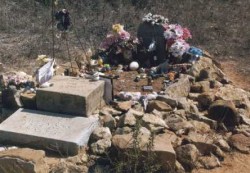 found and left two marbles and a dime on the grave. Some stuff left on the grave by visitors: Nickels, dimes, pennies, toy cars, bead necklace, toy rocking chair, baseball cap, baseball, old lock, plastic horse, teddy bears, plastic flowers/vase, Lion King toy, picture of Jesus, pencils, comb, Duracell battery, sun glasses, keys, cassette tape, lots of angels, Bugs Bunny, and other stuff.
found and left two marbles and a dime on the grave. Some stuff left on the grave by visitors: Nickels, dimes, pennies, toy cars, bead necklace, toy rocking chair, baseball cap, baseball, old lock, plastic horse, teddy bears, plastic flowers/vase, Lion King toy, picture of Jesus, pencils, comb, Duracell battery, sun glasses, keys, cassette tape, lots of angels, Bugs Bunny, and other stuff.
How to get to Sipe Springs: From DeLeon drive Hwy 587 to Sipe Springs. Turn left onto FM 1477 south. Go into and past town. Take second dirt road heading east. Around 1918 an oil boom caused the town to grow to about 10,000 people. When we drove through it Sunday, it was like a Ghost Town. Not much here anymore. By the way, it’s pronounced “Seep” Springs, not like it looks, Sipe Springs.
Somewhere out West there possibly is a family Bible with her name written down and how she died; or a story that is handed down generation to generation. Wouldn’t it be great if we could find out? This, however, will probably remain a mystery forever. “On The Road With Neva and Les” We go to Dublin, Stevenville, Glen Rose and Chalk Mountain. About once a year we head on down to Dublin to the Dr Pepper plant to buy three cases of Dr Pepper. The reason we drive all the way to Dublin is because this bottling plant still uses pure cane sugar in their drinks. Just like we would buy them when we were kids. After we bought our 10 oz. Dr Peppers, we were asked if we would like a tour of the plant. We said, “Yes”. Our guide, Wesley Thomas, took us from the gift shop/soda fountain to inside the bottling plant. First thing, we were given a free, ice cold bottle of Dr Pepper from an old antique machine. You can drink the Dr Pepper as you take the tour, but you have to give them back the bottle. Later that day we were in Glen Rose at an antique shop and saw a bottle like the one we drank from was eight bucks. No wonder they wanted the bottle back. The tour was very interesting and the guide was very informative. You also get to visit the museum where it seems they have everything Dr Pepper ever produced. One large poster is said to be worth over $40,000. After the tour is over, we headed back to the soda fountain. The Dublin Bottling Plant is still in operation with equipment dating back to the 1930’s and produces 500 to 700 cases of drinks each week. It has been in operation since 1891.
In the “Old Days” soda bottles had a cork or stopper. When you removed the cork, it made a loud “Pop”. That’s why they were called “Soda Pop”. In the fifties, we always called them “Soda Pop” or “Soda Water”.
One of the things I love about America is no matter where you go (no pun intended), the restrooms all have toilet paper in them, unless they have run out, and that’s why the rule is “Always check for toilet paper before you sit down.” You can stop at McDonalds, K-Mart, Target, convenient stores, gas stations and on the whole (no pun intended) there is toilet paper. Neva and I were in Mexico on the Yucatan Peninsula and we had stopped at some ruins. We visited the necessary rooms and just outside the door there was a man and woman sitting at a card table. They were busy tearing toilet paper off a roll by single squares and putting them in a little stack to be sold. Yes, sold. No toilet paper in the restrooms. You had to buy a small pile of toilet paper. Yep, it’s good to be in America.

